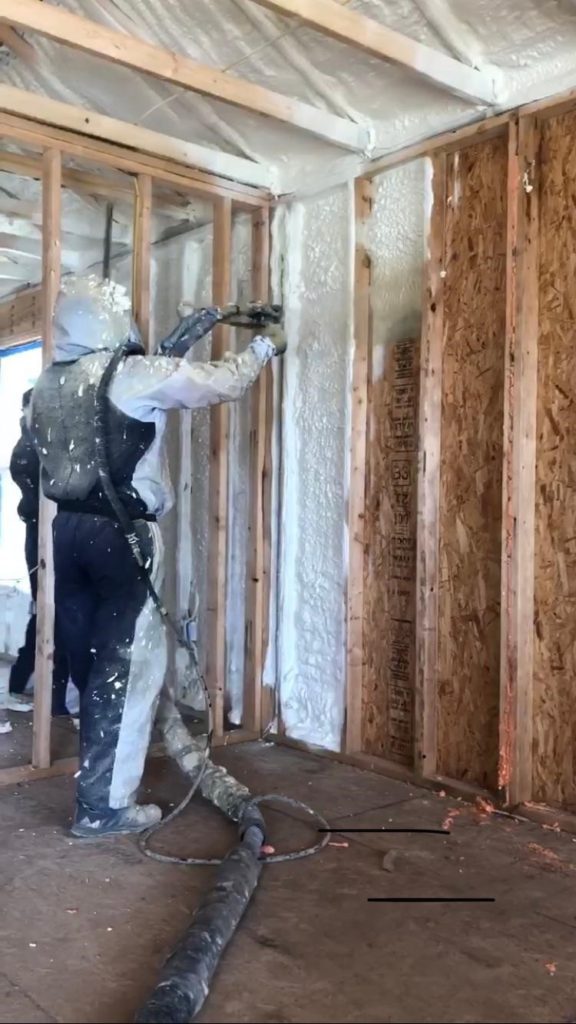Insulating your home or building with spray foam insulation is a great investment. It is becoming the insulation material of choice due to its many benefits. Homeowners and commercial property owners will enjoy huge energy savings by having spray foam insulation installed. Energy-efficient buildings and homes are more valuable and provide better comfort.
What Is Spray Foam Insulation?

Spray foam insulation is made by combining an isocyanate and polyol resin into foam. Polyurethane is the most commonly used material for spray foam. Polyurethane spray foam contains a low-conductivity gas in its cells and is available in two forms:
- Open-cell is a very effective sound absorber. It is spongy due to the air that’s inside the cells.
- Closed-cell is rigid and solid. It is best at preventing air and water from penetrating the walls.
Spray foam insulation provides an extremely tight seal and helps protect against not only air leaks but also moisture. This is normally done with special equipment. Protective gear is worn during the process which is why it is best to hire a professional to complete this type of project.
Making the Right Choice
When deciding whether spray foam insulation material is the right choice for your home, homeowners must make considerations of the advantages and disadvantages. Here is a list of the pros and cons of insulating your home with spray foam.
Pros of Spray Foam
Spray foam insulation has many advantages over alternative insulation products such as fiberglass and cellulose.
1. Sturdiness
Spray foam insulation adds sturdiness to the structure of a house. Other forms of insulation such as fiberglass and cellulose, will sag or settle over time. Spray foam adheres to the structure and stays in place due to its density and hardness. It does not wilt or settle and remains in place for a long time.
2. Cooling and Heating Benefits
Because spray foam expands and dries quickly it is the perfect blockade for exterior hot and cold air. Therefore, spray foam insulation can lower your heating and cooling bills. Although it is more expensive than other types of insulation, it will save you money on energy costs long term.
3. Noise Reduction
Open-cell spray foam can reduce noise. The open cells inside the foam buffer more noise than other types of insulation.
4. Reduces Allergens
One of the benefits of spray foam insulation is reducing the amount of pollen, or allergens that get through the walls. Spray foam reaches the cracks and crevices, prohibiting air from penetrating the walls. By reducing the number of allergens that get into the interior of the building, you will provide a healthier environment for your family or employees.
5. Prevents Mold Growth
Open-cell and closed-cell foam insulation prevent moisture from entering through the walls of your building. As warm air moves through a heated building encountering the cooler air inside, condensation occurs. This moisture is a breeding ground for mold and mildew to grow.
Both open and closed cell types of spray foam reduce the buildup of condensation. Closed-cell spray foam works like a barrier against large quantities of water. The less water that gets through your walls, the lower the risk of developing health issues due to mold and mildew.
6. High R-Value
R-Value measurement refers to the level at which the insulation prevents heat transfer. Therefore, the higher the R-value, the better your protection. Spray foam has the highest R-Value among all types of insulation.
Cons of Spray Foam
While there are many pros to using spray foam for insulating your building, there are a few disadvantages that you should keep in mind before deciding to use it.
1. More Expensive
The cost of spray foam insulation is significantly higher than traditional forms of insulation. The main contributing factor is that it needs to be installed by a professional.
2. Not a DIY Project
The insulation procedure requires experienced professionals and generally isn’t a do-it-yourself project. Spray foam needs to be injected precisely into the blind spots in any building; otherwise, the insulation can be breached at any time. Too little spray foam could cause damage in other ways.
3. Longer Installation Process
The installation process for spray foam insulation takes longer. It is a messy process of mixing the chemicals and then applying them. This is why professionals must wear appropriate protective gear when installing it.
Trusted Building Professionals
If you’ve noticed your energy bills are increasing, consider upgrading the insulation in your home to spray foam. The professionals at RT Construction can help with your insulation by installing spray foam into every crevice to help strengthen the structure of your home. Contact us today for a free consultation.
